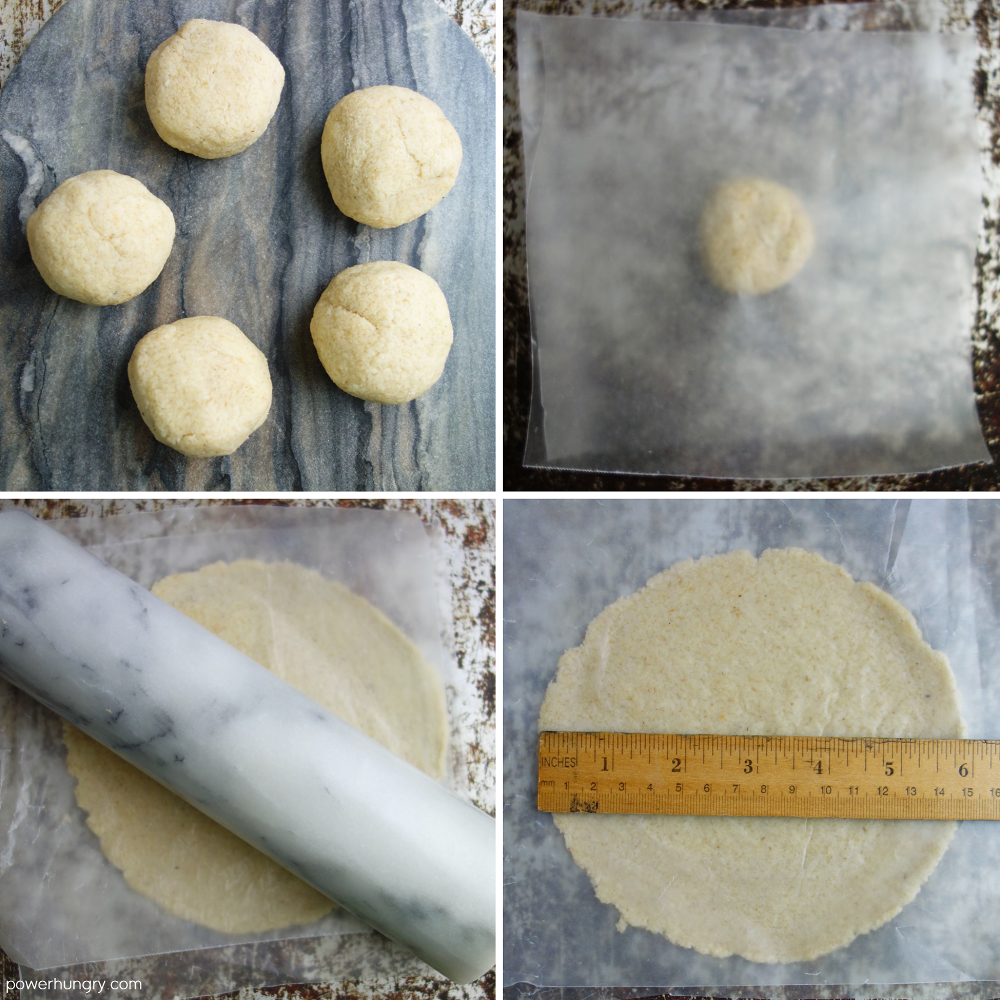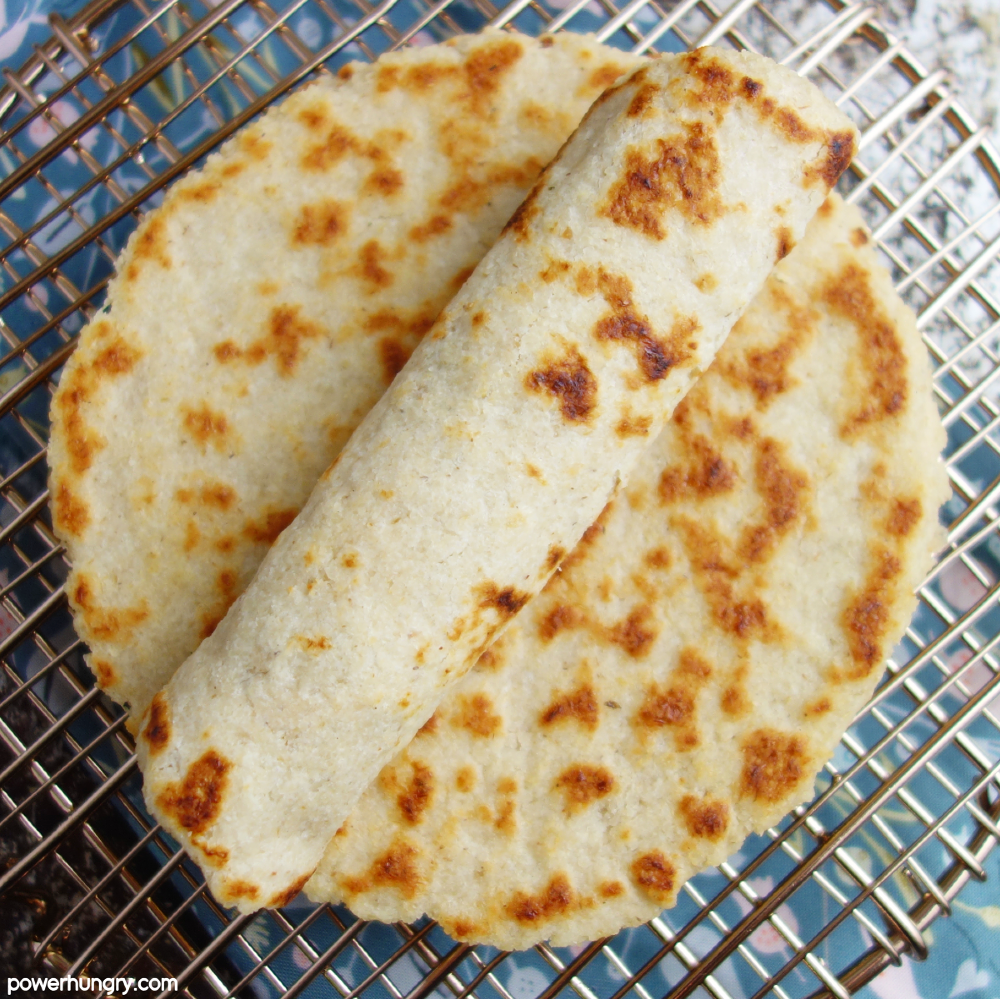Easy to make 2-ingredient almond flour tortillas! Tender & flexible, they are vegan, oil-free, keto, Paleo, & only 2.7 grams net carbs each.
By now, it is probably clear that I love creating recipes that are:
- super simple
- versatile
- made with minimal ingredients
Equally obvious is my fondness for bread. As a native Californian, and a decade+ resident of Texas, my "bread" category will always include tortillas, so the more tortilla recipes, the better!
It explains, in part, why my 2-ingredient coconut flour tortillas are a staple in my kitchen. Made with coconut flour & whole psyllium husks, they are healthy, fluffy, delicious, and go with everything.
But some of you (especially those of you with coconut allergies or sensitivities) have asked for an equally easy recipe that can be made sans coconut.
I am happy--make that overjoyed--to comply with these, my 2-ingredient Almond Flour Tortillas.
Why You Need to Make These
I am overjoyed to share these tortillas because, despite their similarity to the coconut flour tortilla recipe (2 basic ingredients, ease of preparation), they have a unique flavor and texture. They are denser and less fluffy than the coconut tortillas, but in a hearty, filling, satisfying way. They also have a mild, toasty flavor that I know you will love. In other words, an all-around win!
Making the tortillas is a breeze and requires zero previous experience. Nevertheless, if you happen to have worked with play dough at any point in your life, consider yourself highly prepared.
No special equipment is needed, either.
I know that you will want to make a batch as soon as possible, and many more times afterwards.
Healthy Highlights of Almond Flour Tortillas
These wholesome tortillas are nourishing, satisfying, and all of the following, too:
- Vegan (no eggs, no dairy)
- Oil-free
- Paleo
- Keto
- High Fiber (6.2 g per tortilla)
- Grain-free
- Gluten-free
- Low-carb (2.7 g net carbs per tortilla)
- Sugar-free
Only 2 Ingredients Required
Almond flour and whole psyllium husks. are the only two ingredients, besides tap water, needed to make the tortillas. Salt can be added (I like to add a small amount), but it is not required.
Any Substitutions for Almond Flour or Whole Psyllium Husk?
I used finely ground almond flour in my recipe testing. I have not made these with almond meal, so I cannot recommend it as a substitute. You are welcome to experiment (I would love to know if it works for you).
Whole psyllium husks--not psyllium powder--binds the tortillas and gives them their tender, flexible texture. Flaxseed meal and chia will not work in place of the psyllium.
I have not tried making the recipe with psyllium husk powder. I have given recommendations in the recipe notes for subbing psyllium powder for whole psyllium husks, but for best results, stick with whole husks. Note that psyllium powder can sometimes turn recipes purple-ish or brown-ish in color (due to the oxidation from griding the husks)
Step by Step Directions
Step 1: Mix the Dough.
First, whisk the almond flour, psyllium husks, and (optional) salt in a small mixing bowl. If you store the almond flour in the refrigerator or freezer, it will likely have some clumps that need to be broken up. Use a wire whisk or a fork to do so.
Next, add the water, stirring until completely blended. Initially, the mixture will look wet and loose. In seconds, the psyllium will begin absorbing the water, thickening the dough. I recommend letting the dough stand for a full five minutes before proceeding.
Step 2: Divide the Dough.
Shape the moist, springy dough into a smooth ball. Working with this dough is a breeze because it is very forgiving. Do not worry about making mistakes, it is almost impossible to do so.
Place the dough ball onto a cutting board and cut into 5 equal pieces. You can also break it off into 5 equal pieces (whichever you find easier).
Step 3: Shape the Dough.
Roll each piece into a ball. Next, place one of the balls between two sheets of parchment paper or wax paper. Plastic wrap will also work, if that's what you have on hand.
Using a rolling pin, roll the dough into a circle that measures 6 inches (15 cm) across. Perfection is not required, especially after the initial rolling. Simply pinch off pieces of dough from one place and press them into another, as needed.
I do not recommend rolling this portion (1/5) of the dough any larger than 6 inches. It will become too thin to remove from the parchment paper and will likely tear during the cooking process. See my notes at the end for making larger tortillas.
Alternative Methods for Flattening the Dough
No rolling pin? No problem. A large (still filled) can or wine bottle can take its place.
If you have a tortilla press, use it! It will work perfectly to press these evenly and efficiently. Use wax paper or parchment paper to prevent sticking.
You can also use your fingers and palm to press the dough. Press out the dough into a rough circle (do still place the dough between sheets of wax paper pr parchment paper). So long as the tortilla is relatively thin, in same way shape or form, you are going to have great tortillas.
Tips for Removing the Paper from the Tortillas
Once the tortilla is rolled out, carefully peel off the top layer of paper. If a few pieces of dough stick to the paper, simply repress them into the tortilla.
The dough becomes stickier as it gets warmer, so if the paper is really sticking, place the tortilla (in its paper) in the freezer for 3 or 4 minutes (not much longer). The tortilla will come off with ease!
Step 4: Cook the Tortillas.
I recommend using a seasoned cast iron skillet or other nonstick skillet for cooking the tortillas.
Place the skillet over medium-high heat and heat until it is hot (spritz with nonstick spray if using a regular skillet). Place the tortilla, dough side down, into the hot skillet and peel off the remaining piece of paper.
Cook the tortilla for 1 to 2 minutes (it will bubble and puff slightly in a few places). Slide a spatula underneath and lift it slightly to check for browning; once it has many browned spots, flip it over. Cook for 1 to 2 minutes longer until the other side is browned.
Transfer the tortilla to a cooling rack to cool and repeat with the remaining pieces of dough.
Use as you Would Any Tortilla or Flatbread
The texture of these tortillas is like the very best fluffy, white flour tortillas. Use them as you would any tortilla! For example, tacos, burritos, quesadillas, or for scooping up beans, salsa, guacamole, and vegetables.
The tortillas can also be used for making for sandwiches, wraps, desserts (as a sub for crepes), and so much more. Unlike flour and corn tortillas, which are best served warm, these tortillas are also delicious eaten cold or at room temperature.
These tortillas are flexible (especially when warm or room temperature). You can roll them:
Fold in half:
Or quarter them:
Happy eating!
FAQ
Why is My Dough Too Thick or Too Moist?
The answer is measurement.
For the most accurate results, with this and with all recipes that call for alternative flours, a digital kitchen scale is your best friend for consistent recipe results. 1 cup of almond flour can vary from 90 grams to 150 grams, depending on how it is packed or spooned into the measuring cup. But 112 grams of almond flour is always 112 grams of almond flour (the same is true for measuring the whole psyllium husks).
Can I Make Large Tortillas?
Yes! You can divide this quantity of dough in half (to roll 10-inch tortillas) or into thirds (to roll 8-inch tortillas). Use a large skillet and use extra care when turning/flipping the tortillas.
Can I Make the Dough Ahead of Time?
Absolutely! The dough can be made and stored--in an airtight container in the refrigerator--for up to 1 week.
More Grain-Free & Vegan Tortillas to Love:
- 2-Ingredient Coconut Flour Tortillas
- 1-Ingredient Red Lentil Tortillas
- 2-Ingredient Chickpea Flour Tortillas
- 3-Ingredient Sweet Potato Tortillas
- 1-Ingredient Black Bean Tortillas
- Grain-Free Spinach Tortillas {2 ingredients}
- 1-Ingredient Split Pea Tortillas
[tasty-recipe id="22485"]












0 comments